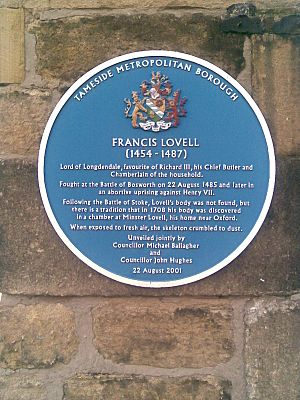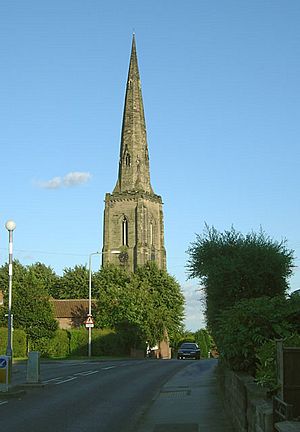Francis Lovell, 1st Viscount Lovell facts for kids
Francis Lovell, 1st Viscount Lovell (born 1456 – probably died 1487) was an English nobleman. He was a strong supporter of King Richard III during the War of the Roses. Francis Lovell, along with Sir William Catesby and Sir Richard Ratcliffe, were among Richard's closest friends. People even called them "the Cat, the Rat and Lovell our dog" in a famous poem that was against King Richard.
After Richard III lost his throne, Lovell continued to fight for the Yorkist side. This was during the early years of King Henry VII's rule. However, Francis Lovell disappeared after the final Yorkist defeat at the Battle of Stoke Field in 1487. His exact fate is still a mystery today.
Contents
Early Life and Family
Francis Lovell was the son of John Lovell, 8th Baron Lovel and Joan Beaumont. When his father died, Francis was only about eight years old. He inherited the titles of Baron Lovel and Baron Holand.
As a young orphan, Francis became a "ward" of King Edward IV of England. This meant the King was responsible for him. Edward IV placed Francis in the care of Richard Neville, 16th Earl of Warwick. Interestingly, Edward's youngest brother, Richard, Duke of Gloucester, also spent time with Warwick. It is believed that Francis and Richard became close friends during this time.
By 1466, Francis Lovell married Anne FitzHugh. She was the daughter of Henry FitzHugh, 5th Baron FitzHugh. Francis and Anne had a daughter named Agnes and a son whose name is not known. Sadly, neither of their children lived past the age of four.
In 1474, Francis inherited a very large estate from his grandmother. This made him one of the wealthiest noblemen in England.
Supporting King Richard III
Francis Lovell became a loyal follower of his friend, Richard, Duke of Gloucester. Their families were also connected through marriage. Francis's wife, Anne FitzHugh, was the first cousin of Richard's wife, Anne Neville.
In 1482, Lovell served under Richard during a military trip to Scotland. Richard knighted him for his service that same year. After King Edward IV died in 1483, Francis became one of Richard's strongest supporters.
Richard became King on June 26, 1483. At his coronation, Francis Lovell carried one of the swords of state. He was also given important roles, such as Lord Chamberlain and a Knight of the Garter. Lovell also helped King Richard stop a rebellion led by Henry Stafford, 2nd Duke of Buckingham in 1483.
In 1484, a poem was put up at St Paul's Cathedral. It made fun of King Richard and his closest supporters. The poem mentioned Lovell, whose family symbol was a silver wolf. It said:
The Catte, the Ratte and Lovell our dogge
Rulyth all Englande under a hogge.
This poem meant that Catesby, Ratcliffe, and Lovell were controlling England under King Richard, whose symbol was a white boar.
After the Battle of Bosworth
In June 1485, Francis Lovell was given the job of guarding the south coast of England. His task was to stop Henry Tudor from landing there. However, Henry Tudor landed in Wales, avoiding the strong defenses.
It is believed that Lovell fought for King Richard at the Battle of Bosworth Field on August 22, 1485. While some early reports said he died there, he actually escaped. After the battle, Lovell found safety at Colchester. From there, he escaped and tried to start a rebellion in Yorkshire against the new King Henry VII.
When this plan failed, Lovell tried to capture Henry VII in York by himself. He may have even been involved in an attempt to harm the King. After these attempts failed, he fled to Margaret of York in Flanders. Margaret was King Richard III's sister.
As a main leader of the Yorkist party, Lovell played a big part in Lambert Simnel's plan. Lambert Simnel was a young boy who pretended to be a prince who had a claim to the throne. Lovell went with Simnel to Ireland and fought for him at the Battle of Stoke Field on June 16, 1487.
Lovell was seen escaping from the battle. He might have gone to Scotland, as a safe travel pass was issued for him there in 1488. However, there is no proof that Lovell ever reached Scotland or lived there. After this, no one knows what happened to him.
Francis Lovell's wife, Anne Fitzhugh, received money from the King in 1489. She was still alive in 1495, but the date of her death is not known.
What Happened to Francis Lovell?
Historian Francis Bacon wrote that some people believed Lovell lived for a long time afterward in a secret cave or vault.
More than 200 years later, in 1708, a skeleton was found in a hidden room at the Lovell family home in Minster Lovell in Oxfordshire. People thought it might be Francis Lovell, who had hidden there and died from lack of food. However, this story is probably not true. Francis Lovell rarely spent time at Minster Lovell. Also, the manor had been given to Henry Tudor's uncle, Jasper Tudor, Duke of Bedford, making it a very risky hiding place for Lovell.
Another idea comes from a visit to All Hallows' Church in Gedling, Nottinghamshire. In 1903, a very old stone slab was found there. It was thought to be the grave of a knight from the 15th century who fought at the Battle of Stoke. Gedling Church is only a few miles from the battlefield. It is possible that Francis tried to escape across a nearby river but was killed or died later from his injuries. His body might have been secretly buried in the church to prevent a severe punishment if he had been captured.
Images for kids





